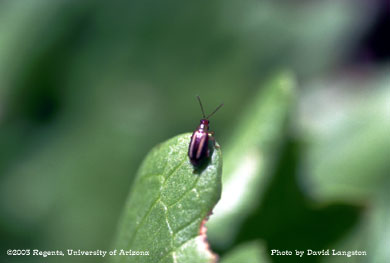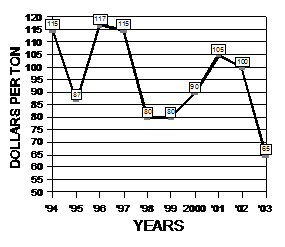Alfalfa Report
Yuma County, Arizona
November 3, 2003
Yuma County Office
2200 W. 28th Street, Ste. 102
Yuma, AZ 85364
(928) 726-3904
(928) 726-8472 FAX
Production Update:
Frost Management: Frost-damaged alfalfa has lower quality due
to leaf loss, lower digestibility, and deceased mineral content. Frost-damaged
alfalfa may also accumulate toxic levels of nitrates in rare cases. Water
application during freezing temperatures can raise the temperature, but
waterlogging can produce negative effects. In the case of alfalfa, the
best protection against frost is a healthy crop. Severe frosts can kill
the tops of the alfalfa plant and new growth must occur from the base
of the plant. Cutting alfalfa after a frost can stimulate this new growth
near the base of the plant, but the new growth is then susceptible to
subsequent frosts.
Insect Management: Adult palestriped flea beetles often migrate to seedling alfalfa stands. Adults feed on the upper leaf tissues leaving windows. Seedling alfalfa can often sustain much feeding damage without hurting stand establishment.

Weed Control: Both Raptor and Pursuit can be used on
seedling alfalfa. The advantages of Raptor are that it will control lambs
quarter, sowthistle and grasses which are not controlled by Pursuit. It
also has less soil residue and is not as much of a problem to sensitive
crops grown in rotation. The advantage of Pursuit is that it has long
soil residue and will control multiple flushes of broadleaf weeds. In
some cases, combining these two herbicides will be a good option.
| Market Summary |
High
|
Low
|
Average
|
Off grade
|
| Past 2 Weeks (Oct 21- Nov 3, 2003) |
70
|
55
|
65
|
50-55
|
| Last Year (Oct 21 - Nov 3, 2002) |
105
|
95
|
100
|
80-90
|
10 Year Summary (Oct 21 - Nov 3, 1994-2003):

Issued in furtherance of Cooperative Extension work, acts of May 8 and June 30, 1914, in cooperation with the U.S. Department of Agriculture, James A. Christenson, Director Cooperative Extension, College of Agriculture and Life Sciences, The University of Arizona.
The University of Arizona is an equal opportunity, affirmative action institution. The University does not discriminate on the basis of race, color, religion, sex, national origin, age, disability, veteran status, or sexual orientation in its programs and activities.
Any products, services, or organizations that are
mentioned, shown, or indirectly implied in this web document do not imply
endorsement by The University of Arizona.
Information provided by:
Barry Tickes, btickes@ag.arizona.edu Extension Agent, Yuma County
Michael Ottman, mottman@ag.arizona.edu Agronomy Specialist
College of Agriculture, The University of Arizona.
Eric Natwick, etnatwick@ucdavis.edu UCCE Imperial County - Farm Advisor
University of California, Davis, CA.
Forages: Crop Mgmt | Soil Mgmt | Irrigation | Alfalfa Reports | Insects | Diseases | Weeds | Pesticides
Home | Other Crops | Forages
For more Arizona Production Ag Information:
Home | Cotton | Veggies| Forages | Grains | Citrus | Crop x Crop | Insects | Diseases| Weeds | Pesticides | News | Weather | Research | Photos | Contacts | General Info. | Site Map
Copyright © 2001 University of Arizona,
College of Agriculture and Life Sciences
Webmaster: Al Fournier (fournier@ag.arizona.edu)